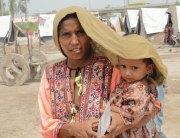Ten years ago today, world leaders in Hyogo, Japan agreed on a framework to better manage risk and curb the impact of disasters in the wake of the devastating Indian Ocean tsunami – which claimed some 227,000 lives – and in March, they are set to meet for a United Nations conference in another Japanese city to take stock of whether the world has lived up to that promise.
The Hyogo Framework for Action (HFA), the outcome of the 2005 World Conference on Disaster Reduction, is the first plan to detail the work required from all different sectors and actors to reduce disaster losses. Looking to update that landmark agreement at a follow-up conference, global leaders in mid-March will head to Sendai, the centre of the Tōhoku region, which bore the brunt of the 2011 earthquake and tsunami that led to the Fukushima meltdown.
“The evidence of the last decade – which has been marked by some of the worst natural disasters on record – is far from favourable,” says Margareta Wahlström, Head of the UN Office for Disaster Risk Reduction (UNISDR) in an op-ed, published ahead of the Third World Conference on Diaster Risk Reduction, for the Project Syndicate website.
To spotlight the need for action, she sets out a litany of tragic signposts that mark the road to Sendai: Port-au-Price collapsed in an earthquake. Hurricane Katrina devastated New Orleans. Drought killed an unknown number of people in the Horn of Africa. Floods and earthquakes affected millions in Pakistan and China. Heat waves and wildfires ravaged countries around the world.
These incidents, she continues, are ‘stark reminders’ of the need for instruments like the HFA, especially because the drivers of risk – improper land use, non-existent or poorly implemented building codes, environmental degradation, poverty, climate change, and, most important, weak governance by inappropriate and insufficient institutions.
But there have been some important successes of the last decade, says Ms. Wahlström. “In Asia, where 80 per cent of the world’s natural disasters are concentrated, the number of people directly affected has dropped, decade-by-decade, by almost one billion, owing to measures like the Indian Ocean early warning system.”
Timely evacuations in the face of accurately forecasted major storm systems have enabled the Philippines to save thousands of lives just in the last year. And over the last three years, China has worked hard to keep economic losses within its 1.5 per cent-of-GDP target.
Meanwhile, Turkey will have earthquake-proofed every school and hospital in the country by 2017, Ms. Wahlström continues, while adding that Ethiopia has developed a sophisticated data management system to help guide its efforts to address not only drought but also other natural hazards. Both countries – and many others – have incorporated the study of disaster risk into their school curriculums.
And the European Union has estimated that €1 ($1.18) spent on flood protection brings €6 in savings. She goes on to say that in the United Kingdom, investment in flood defences meant that 800,000 properties were protected during last winter’s storms, significantly reducing the bill for response and recovery.
Nonetheless, noting that 2015 marks the 20th anniversary of the devastating Kobe earthquake, Ms. Wahlström points out that in the past 44 years, disasters caused by weather, climate, and water-related hazards have led to 3.5 million deaths, according to UNISDR. Even where people’s lives are saved, their livelihoods are often decimated. Since 1960, disasters have cost the world more than $3.5 trillion, which both developed and developing counties paying a huge price.
“That is why world leaders, through the HFA, need to agree to scale up efforts to cope with the risks posed by rising sea levels, global warming, rampant urbanization and rapid population growth,” she says, adding: “Only with strong political commitment at the highest level can real progress towards a safer, more sustainable future be made.”
With that in mind she says that it should not be difficult to win support for a revised HFA. “After all, there is no compelling – or even rational – reason which a finance minister or CEO would choose to pay for recovery but not invest in prevention.”
“If the UN conference produces the right agreement, resilience can become the hallmark of 2015, setting the tone for agreements later in the year on climate change and sustainable development – both of which hold important implications for disaster risk,” Ms. Wahlström concludes.
via UN News Centre



















Follow Us